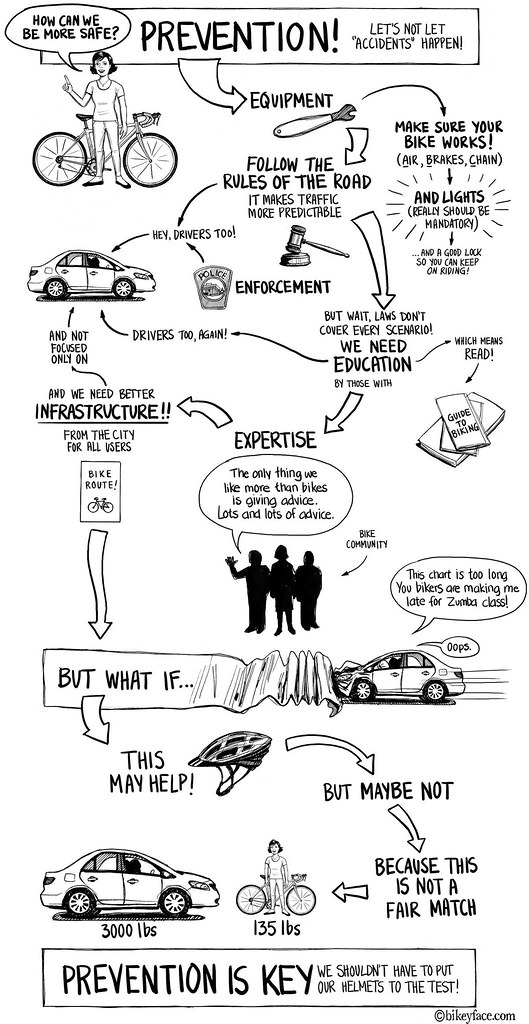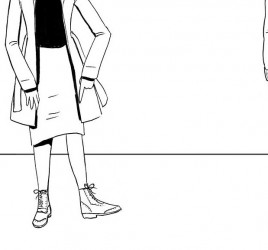
Serious about Safety
Every bike commuter knows is that safety is a complicated issue. They face it every day. However, some safety campaigns focus entirely on helmets. But that means there’s been a crash. What if it could have been prevented? Wouldn’t that be safer?
There’s many points along the way where an individual, a community, and a city, can prevent more tragedies from happening. Helmet or not, when you put a car against a vulnerable road user, you know who the victim will be. Cities need to get real about safety. No excuses.





Great cartoon! Bicycles need to be provided with a larger share of the Public Space that will keep them safe from cars and away from pedestrians. In the Netherlands where no one wears helmets for utilitarian cycling, the injury and death rates of cyclists are minuscule compared to the US because they have a greater share of the Public Space which keeps them safe from cars and away from pedestrians. Netherlands – 1.1 killed per 100 million km cycled, 1.6 injuries per 10 million km cycled. USA – 5.5 killed per 100 million km cycled, 33.5 million injured per 10 million km cycled. Based on a 5 year average (2004-2008). Statistic from “City Cycling” by John Pucher & Ralph Buehler. http://citycyclingbook.wordpress.com/
Relying on John Pucher and Ralph Buehler for cyclist injury statistics is like relying on Bernie Madoff for investment advice.
A reference for that claim would be really, really helpful. They publish their work in peer-reviewed journals, and nation-sized mortality statistics are not easily fudged. They have citations, you can actually track them down and check them. Bluster is not rebuttal.
In 2004-2005, the fatality rate per 100 million km was 1.1. 1.5, 1.7. 3.6, and 5.8 in the Netherlands, Denmark, Germany, UK, and the US respectively, with these figures obtained from the respective national transportation agencies. These were reported by the OECD in 2007, and Pucher and Buehler cited them in their 2008 Transport Reviews article (p. 506).
The injury number that they cite is the more conservative one provided by the US DOT; the CDC’s number based on ER reports is over 10 times higher (however, it makes sense to compare like with like, one might assume that other DOTs similarly underreport).
I confirmed the Dutch fatality number from page 191 of this OECD document: http://www.internationaltransportforum.org/irtadpublic/pdf/10IrtadReport.pdf
Have you perhaps underestimated the reliability of Pucher and Buehler? Would you perhaps reconsider some of your other opinions about their work?
Ian, the modal share of cycling in the Netherlands makes that in the US look like a joke. The demographic there includes far more vulnerable users like schoolchildren and pensioners. And yet, they have far fewer injuries and deaths per mile cycled. A whole country is proving you wrong.
None of this is down to in-depth conjecture based on the research you like to be so snide about. There are simple overwhelming stats.
And it’s safe because they all cycle at walking pace? Please will you listen to yourself! There are plenty of videos of fast cycling in the Netherlands on YouTube ( http://youtu.be/YJ5Qertz2OA ) , and the Dutch themselves argue that sports cyclists are perfectly happy training there. Of course it’s slower in town in the rush hour because there are SO MANY CYCLISTS. Where I commute in the UK I get caught up in queues of cars, buses and lorries. I know which I’d prefer.
Did you ever stop to wonder if you are in a minority on here because you’re wrong?
Forester and Franklin have had their chance. The numbers are in and they blew it. I don’t anticipate any remorse on their part for the lost years of life – not in accidents, but because their insistence on, and support for, vehicular cycling has helped scare nearly all the potential cyclists off the roads. People who might have loved to ride a bike to work or the shops will be sitting in front of the TV now, nursing their diabetes.
But maybe we can realise when to follow a good example and make things better.
For those still wondering if good-quality cycle infrastructure is really dangerous and slow, some pictures:
http://bit.ly/NxKAf1
Right on! I’m going to spread this post to my fellow Jacksonville based bike advocates.
Excellent points, and I am surprised this discussion does not happen more frequently and at a higher level within the cycling community.
I would personally add using a rear-view mirror can be more useful than wearing a helmet. The former goes under the “avoid crashes” column while the latter is in the “survive crashes” column. When you are riding in traffic, I think you are more naked without a mirror than without a helmet.
Good one Murali !
Finally, someone brought up THE most important piece of equipment on a bike, A MIRROR !!! I have NO problem riding thru downtown Boston with cars 12″ off my left hip. Why ? Because I can see what they are up to / doing !
Try driving in your car for an hour, and never, NOT once check any of your mirrors. I’ll bet you can’t / won’t do it ! So how anyone can climb on a bike, and not protect themselves (and their loved ones by getting back home safely) with something as simple as a mirror is beyond me…
GG.
Cut down road accidents drastically : the right/correct attitude by everyone who is using/ while on the road. “Accidents” (occuring by chance/unplanned/not premeditated) will still happen.
l
Re “… when you put a car against a vulnerable road user …”
We’re vulnerable, and motorists aren’t? About 100 motorists are killed by themselves and/or other motorists every day in the U. S.
Misconceptions about comparative safety are an important part of the foundation of stoking irrational fears to build support for facilities that make riding safely more complicated, and/or more likely to get you honked at, and/or illegal, depending on your jurisdiction. (Happily for me, the Ohio State Legislature no longer allows local governments to require bikers to use sidewalks, bike lanes, sidepaths, or “cycletracks.”)
For some recent information about the safety of wonderful cutting-edge innovative facilities, see http://blog.oregonlive.com/commuting/2012/10/right-hook_crashes_increasing.html#incart_river_default.
More important than a helmet, I think, is learning the difference between “feeling safe” and being safer, and riding accordingly. The cartoon is absolutely right when it says “WE NEED EDUCATION.” It doesn’t take much of it of it before you begin to recognize MIS-education, whether it’s ad hominem attacks (see above), or painted lines on the pavement.